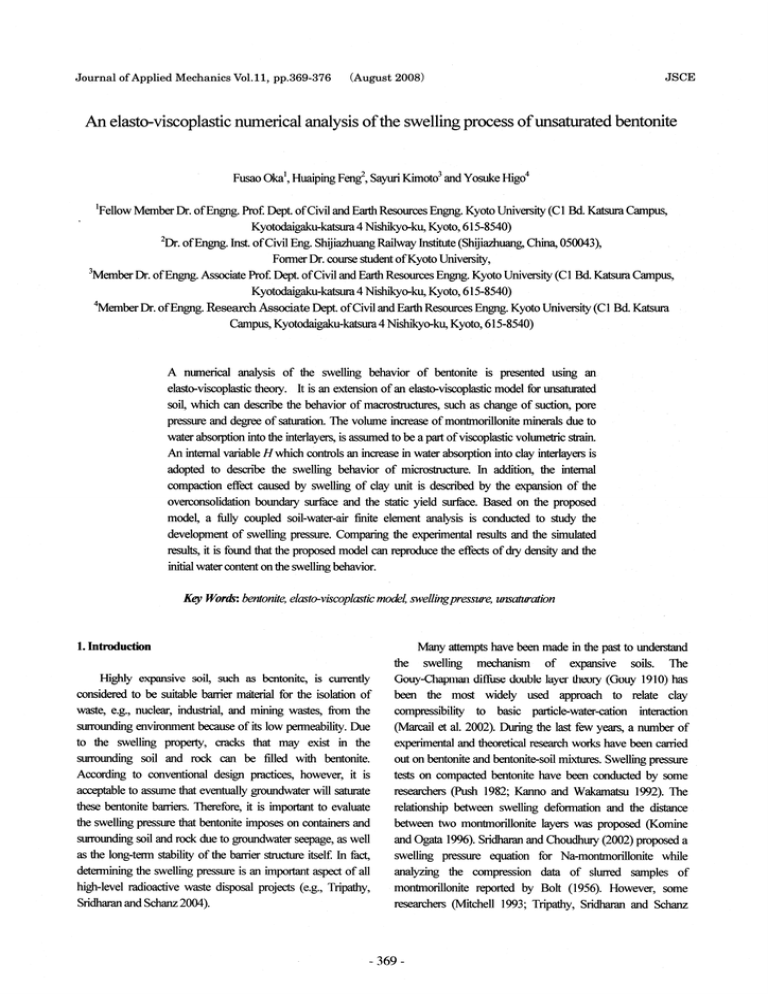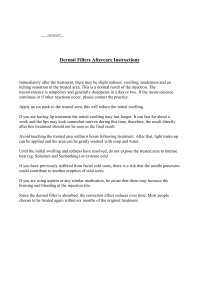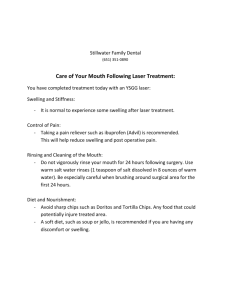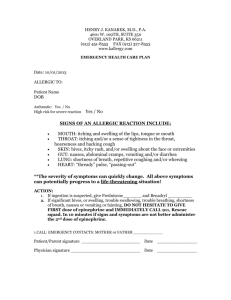An elasto-viscoplastic
advertisement

Journal of Applied Mechanics Vol.11, pp.369-376 An elasto-viscoplastic (August 2008) JSCE numerical analysis of the swelling process of unsaturated bentonite Fusao Oka1, Huaiping Feng2, Sayuri Kimoto3 and Yosuke Higo4 1FellowMemberDr. of Engng.Prof Dept.of Civiland EarthResourcesEngng.KyotoUniversity(Cl Bd. KatsuraCampus, Kyotodaigaku-katsura 4 Nishikyo-ku,Kyoto,615-8540) 2Dr. of Engng.Inst.of CivilEng. ShijiazhuangRailwayInstitute(Shijiazhuang, China,050043), FormerDr. coursestudentof KyotoUniversity, 3MemberDr. of Engng.AssociateProf.Dept of Civiland EarthResourcesEngng.KyotoUniversity(C1Bd. KatsuraCampus, Kyotodaigaku-katsura 4 Nishikyo-ku,Kyoto,615-8540) 4MemberDr . of Engng.Research Associate Dept of Civiland Earth ResourcesEngng.KyotoUniversity(C1Bd. Katsura Campus,Kyotodaigaku-katsura 4 Nishikyo-ku,Kyoto,615-8540) A numerical analysis elasto-viscoplastic of the swelling theory. behavior of bentonite is presented using an It is an extension of an elasto-viscoplastic model for unsaturated soil, which can describe the behavior of macrostructures, such as change of suction, pore pressure and degree of saturation. The volume increase of montmorillonite minerals due to water absorption into the interlayers, is assumed to be a part of viscoplastic volumetric strain. An internal variable H which controls an increase in water absorption into clay interlayers is adopted to describe compaction overconsolidation model, the swelling behavior boundary In addition, the internal surface and the static yield surface. Based on the proposed a fully coupled soil-water-air development of microstructure. effect caused by swelling of clay unit is described by the expansion of the finite element analysis is conducted of swelling pressure. Comparing the experimental to study the results and the simulated results, it is found that the proposed model can reproduce the effects of dry density and the initial water content on the swelling behavior. Key Words: bentonite, elasto-viscoplastic model, swellingpressure, 1. Introduction Highly expansive soil, such as bcntonitc,is currently consideredto be suitablebather materialfor the isolationof waste, e.g., nuclear,industrial,and mining wastes, from the surroundingenvironmentbecauseof its low permeability.Due to the swelling property, cracks that may exist in the surrounding soil and rock can be filled with bentonite. According to conventional design practices,however, it is acceptableto assumethat eventuallygroundwaterwill saturate these bentonitebathers. Therefore,it is importantto evaluate the swellingpressurethat bentoniteimposeson containersand surroundingsoil and rock due to groundwaterseepage,as well as the long-termstabilityof the barrierstructureitself In fact, determiningthe swellingpressureis an importantaspectof all high-levelradioactivewaste disposalprojects (e.g., Tripathy, Sridharanand Schanz2004). unsaturation Many attemptshave been made in the past to understand the swelling mechanism of expansive soils. The Gouy-Chapmandiffusedoublelayer theory (Gouy 1910)has been the most widely used approach to relate clay compressibility to basic particle-water-cationinteraction (Marcailet al. 2002). Duringthe last few years, a number of experimentaland theoreticalresearchworks have been carried out on bentoniteand bentonite-soilmixtures.Swellingpressure tests on compactedbentonitehave been conductedby some researchers(Push 1982;Kanno and Wakamatsu 1992).The relationshipbetween swellingdeformationand the distance between two montmorillonitelayers was proposed (Komine and Ogata 1996).Sridharanand Choudhury(2002) proposeda swelling pressure equation for Na-montmorillonitewhile analyzing the compression data of slurred samples of montmorillonitereported by Bolt (1956). However, some researchers(Mitchell 1993; Tripathy, Sridharanand Schanz ― 369― 2004)have shownthat verylittleinformationis availableon the use of the diffusedoublelayer theoryfor the determinationof the swellingpressureof compactedbentonite. Numericalmodelshave also been proposed to simulate expansivesoil (Alonsoet al. 1991and 1999;Gens and Aloso 1992) based on the elastoplastictheory. Accordingto their theory, two levels are distinguishedfor the structure,(1) a microstructural levelthatcorrespondsto the activeclayminerals and their vicinityand (2) a macrostructurallevelthat accounts for the larger structuralsoil arrangements.The microstructure, namely,the swellingdomain that expandswhen hydrated,is thoughtto be water-saturatedeven at high levelsof suction.In contrast,the macrostructureis assumedto be unsaturatedwhen subjectedto suction,and its behaviormay be describedby a conventionalframeworksfor unsaturatedsoils. In addition,a theoreticalmodel has been proposed by Shuai and Fredlund (1998) to describe the volume changes during various oedometerswellingtests. In the present paper, an elasto-viscoplastic for unsaturated bentonite elasto-viscoplastic model is developed for unsaturated swelling model based on the soil. An internal variable H, which controls the growth of the absorption of water into the clay interlayer, is introduced to describe the large volumetric expansive behavior of the microstructure. namely, solid (S), water (W), and air (G), which are continuouslydistributedthroughout space. Volume fraction na is definedas the local ratio of the volume element with respecttothe totalvolume,namely, (1) The volume fraction of the void, n , is written as (2) Finally, the material density p, for a phase is given by (3) where M a is the mass The effectives saturated soil; of stress for compressible. In present as the stress tensor „qij the defined stress soil where the stress skeleton skeleton variables. stress" is obtained by effective study, as the "average values,„qaij, been unsaturated are adopted same has however, reconsidered suction a phase. from needs to fluids are tensor and stress is tha (2000). Total of the partial stress namely, This model includes the effects of suction and the swelling effect into the hardening parameter. Using the proposed model, be the Jommi sum for stress Skeleton by the Terzaghi (4) the (5) swelling behavior of bentonite is simulated by the multi-phase finite element method. (6) 2. Elasto-viscoplasticconstitutive model for unsaturated swellingsoil where gas Adoptingskeletonstress and suctionas the stress variables, an elasto-viscoplasticmodel for unsaturatedsoil has been proposed (Oka et al. 2006; Feng et al. 2006; Oka et al. 2008). Based on this model, three-dimensionalmultiphase numericalanalysishas been carriedout. The simulationresults showthat the behaviorof unsaturatedsoil,such as the changes in poreair pressure,pore waterpressure,and volumetricstrain, can be simulatedwell with this model (Oka et al. 2008).This model also can describe the viscoplasticvolumetriccollapse phenomenon due to decrease of suction. To reproduce the swellingphenomenon caused by the clay particles, such as montmorilloniteparticles,the elasto-viscoplasticconstitutive model for unsaturatedsoil is extendedto be able to reproduce the volumetric swelling. In the present model, a swelling equation is proposed to describe the viscoplasticvolumetric swelling. 2.1 Skeleton stress and nG are the phase,„qij is average the pore pressure, volume skeleton PF fraction stress is defined of liquid phase and present study, the in the as, (7) where Sr is the degree of saturation. 22 Stretching It is assumed that the strain rate tensor consists of elastic stretching tensor Deij, the viscoplastic stretching tensor Dvpij,and an additional viscoplastic microstructural stretching tensor Dyvp(s)ij due to the swelling. Total stretching tensor Dij is defined in the following equation: (8) The elastic stretching tensor Deij is given by a generalized Hooke type of law, namely, (9) where The material to be modeled is composed of three phases, nw skeleton •\ 370•\ Sij is stress, the G deviatoric is the stress elastic tensor,„qm shear modulus, is the e0 mean is the initial void ratio, K is the swelling index, and the superimposeddotdenotesthe timedifferentiation. 2.5 Overconsolidation BoundarySurface In the model, the overconsolidationboundary surface is defined to delineate the normal consolidation(NC) region, 2.3 fb>0, and the overconsolidation(OC) region, fb<0, follows: Swellingdue to absorptionof water into the interlayers of clay particles From the experimentalresults on bentonite (Komine and Ogata 1996;Push 1982),it has been shown that the swelling phaseis followedby an asymptotictendencytowardsa constant final value. In the model, an evolutionalequation is used to describethe viscoplasticvolumetricswellingof theparticlesas (10) (12) (13) where nij* is denotes (11) as the the the state initial state stress ratio at the end before =•@ tensor of the consolidation, deformation at the (nij*=Sij/„qm), occurs. critical and in other (0) words, M.*m is the value state Mf. „qmb of is the n* where H is an intemal variable that describes the growth in the absorption of water into the clay particles, and A and B are strain-hardening material parameters. size of the boundary Figure 1 shows the swelling equation and softening parameter, which controls the surface. curves at various values for parameters A and B. It can be seen that A is a parameter for the potential of the absorption of water, 2.6 and B is a parameter which controls the evolution rate of H. Static yield function To describe the mechanical behavior of clay at its static equilibrium state, a Cam-clay type of static yield function is 2.4 Internalcompactionphenomenon With the absorption of water into the interlayers,the distancebetweenthe two plateletsincreasesfrom 15A to 20 A. Figure2 illustratesthe swellingprocessin the case where the swelling deformationis restricted.With wetting, the macro voids graduallybecomespackedwith swollenmontmorillonite particles.As shownin Figure3, the SEM imageof the wetting process of the bentonitehas been reported by Komine and Ogata(2004),in whichthe bentonitecontentis 100%.It can be seen that the macro voids are finallyfilled up by the volume increasein bentonite. As a result,the sample becomes stiffer and has a higher strength,which is similarto the soil being highly compacted. Hereafter,the phenomenonis calledthe "internal compaction effect";it is differentfromtraditionalcompactioninthe changes inwatercontent assumed to be (14) where „q(s)my is which controls 2.7 Hardening According soil (Oka the strain-hardening rule to the in of viscoplastic considering internal compaction model hardening Eqs. et al. 2006), (11) strain evpij and (13) and parameter function. Feng are suction for effect unsaturated parameters: assumed „qm Pc to be as follows: (15) (b) Swelling equations with different parameters for A and B •\ 371•\ yield softening elasto-viscoplastic (a) Fig. 1 and size of the static et al. 2006; b and „q(s)my function the During water uptake Before water uptake Platelets Water and cation Bentoniteparticles (beforewetting) particles swollen by absorbing water into interlayers Platelets Fig.2 Benotonite (Kunigel-V1Void Bentonite Process of swelling with restricted deformation Voids are filled up completely by the volume increase of bentonite absorbing water Process of filling the voids by the volume increase of bentonite can be observed Before water supply After water supply Under water supply Fig.3 Swellingbehaviorof bentonite(bentoniteA, Kunigel-V1)(Komine and Ogata2004) soil when material parameter decrease in „qmb (16) where Evpkk are the e0 is viscoplastic compression is the used the and initial void to describe the assumed to volumetric the swelling ratio. „qma effect decrease index, and structural an increase In the expressed and surface, and to reference which with present as the equals changes study, expansion the static controls yield suction the rate Pic of . Sd is a increase or in suction. the internal of the surface compaction overconsolidation effect is boundary as follows: parameter degradation, in K respectively, is a strain-softening of with strain, ƒÉ the suction which viscoplastic (19) is strain, namely, (20) (17) where Evp*kk is the viscoplastic volumetric strain including the (18) in which, „qmai for „qma, respectively, controls strain and „qmaf the is rate equal consolidation The the of last terms suction effect and zero at the the initial on is equal (15) and unsaturated and the a material changes. stress „qmbi in Eqs. initial ,B is structural to yield are final the state, we (21) values parameter Since where, r that viscoplastic obtain are soil, in is adopted to reflect the percentage of the swelling viscoplastic strain considered, which varies from 0 to 1. r being equal to 0 means that the swelling viscoplastic strain does the not affect the expansion or shrinkage of the overconsolidation to „qmai. (16) special swelling effect taken into account which is defined as adopted which boundary surface and the static yield boundary surface, while to reflect Pc is and SI being equal to 1 means that the viscoplastic the swelling r volumetric strain has an effect on expansion of the boundary present a material suction values, parameter Pci denoting is the reference the strength suction, ratio to the saturated is surface. •\ 372•\ 2.8 3.1 Viscoplastic potential function Conservation of momentum The momentum balance for each phase is obtained with the The viscoplastic potential function is given by following equations when the acceleration is disregarded, (22) where M* (27) is assumed to be constant in the NC region and varies with the current stress in the OC region as NC region OC region (28) (23) (29) where „qmc intersection axis. denotes of the the mean overconsolidation skeleton stress at the boundary surface and the in which „qm water and gas phases Fi is the body force and the interaction between DWG and DGW is assumed to be zero. the interaction between solid phase and other two phases are 2.9 Viscoplasticflow rule The viscoplasticstretching tensor is expressed by the following equation which is based on Perzyna's type of viscoplastictheory(Perzyna,1963;Kimoto& Oka 2005)as (24) in which <> are Macaulay'sbrackets; if fy>0 and indicatesstrain rate sensitivity.Based on the experimentaldata fromthe strain rate constanttriaxialtests,the materialfunctionis givenas (25) given as (30) in which, g is the acceleration of gravity, kw and k G are the permeability coefficients for water and air phase, respectively. The sum of Eqs. (27)-(29) leads to (31) Finally, we used the rate type of conservation of momentum neglecting body force for updated Lagrangian scheme, which is given by (32) (26) 3. Multiphase finite element formulation for the analysisof unsaturated bentonite It is foundthatthe waterabsorbedinto theseaggregatesdoes not flow,which can be consideredas a part of solid phase. In contrast, the micro pores between the clay aggregatesare assumedto be occupiedby free water and air, which can be describedwithin the frameworkof a macroscopiccontinuum mechanicalapproachthroughthe use of the theory of porous media. Proceeding from the general geometrically non-linear formulation,the governing balance relations for multiphase materialcan be obtained(e.g., Ehlers 2004; Loret and Khalili 2000).Using the skeletonstressand suctionas stressvariables, Oka et al. (2006) and Kimoto et al. (2007) proposed an air-water-soil coupled finite element model. And a three-dimensionalnumericalanalysishas been carriedout to investigatethe triaxialbehaviorof unsaturatedsilt (Feng et al, 2006). where 32 Sij is the total nominal stress rate tensor. Conservation of mass The conservation laws of mass for liquid and gas phase are given in the following equations: (33) (34) where Vwiand VGi are the apparent velocity for water and air, n is the porosity, 3.3 Di, is the stretching tensor. Soil water characteristic curve The relation between suction and saturation is given in the following equation proposed by van Genuchten (1980) (35) where a , m, and n are material parameters and the relation m=1-1/n saturation. •\ 373•\ is assumed.Sre is an effective degree of 4. Simulation results water contentvalues (SW5, SW6),a larger r value (0.3) is used to representthe initialhardeningeffect. In the finite element analysis,an eight-nodequadrilateral element is used for the displacementand the four nodded elementis used for the pore pressure.The finiteelementmesh and boundaryconditionsfor the simulationare shownin Figure 4. The bottomboundaryis assumedto be the wettingboundary with water pressure of 10 kPa. The other boundaries are assumed to be impermeablefor water and air. The main Table 1 Material parameters parametersand initialconditionsare listed in Table 1. Elastic shear modulus, viscoplastic parameter C, SI, Sd, air permeability,and shape factor a and b are assumed and the other parameters are determined by the existing data (Horikoshiet al. 2007).For the initialporewater pressure,i.e., initialsuctionis assumedto be 100kpawhich is smallerthan the expectedone. The reasonis thatthe initialsuctionis onlyfor the initialmatrixsuctiondue to the meniscusbetweenparticles. Fig.4 Table2 Experimentalcases(Ono,2006) Finite element mesh and boundary conditions Figure5 showsthe changesin the degreeof saturationfor each elementwithwetting.In this analysis,it is assumedthatthe element starts swellingwhen the saturationreaches a given value. From Figure5, it can be seen that swellingstartsfrom bottomelementand movesupwards,elementby element. To investigate the swelling behavior of bentonite, as shown in Table 2, swelling pressure tests of bentonite (KunigeruGX)have been carriedoutby Ono et al.(2006).The experimentalresultsare shown in Figure 6(a). It is confirmed that dry densitycontrolsthe finialswellingpressure.Meanwhile, initialwatercontentaffectsthe typeof swellingcurve. In the model, parameter A is adopted to describe the swellingpotential,namely, thy density effect.The parameter in Eq.(21) is a parameterused to describe ther "intemal compactioneffect".Consideringthat the initialwater content also can lead to some degree of swelling.It is reasonableto investigatethe swellingbehaviorwith differentdry densityand initial water content by adoptingproper value of A and r . Table3 liststhe value of A and y used in this simulation.For casesSW3 and SW6, withhigherdry densities,higherA values (0.18, and 0.16) are adopted. For cases with higher initial Fig. 5 Simulation results of degree saturation-time relation with wetting of The predictedswellingpressuresduringwettingprocessare shown in Figure 6(b). Simulationresult shows that large parameterA givesthe largemagnitudeof swellingpressure.It is •\ 374•\ Table 3 Parameter for simulation seenthatthe effectof dry densitycanbe describedby parameter A. Accordingto experimentalresults, for samples with high initialwater content,such as SW5 and SW6, swellingpressure increasesmonotonically,while a time-softeningbehaviourcan be observedin the sampleswith low initialwater content,such as SW2, SW3. As mentionedbefore,parameter y is adopted to describethe "internalcompactioneffect"in this model.The softeningcomes from the structuraldegradationeffectby the parameter B (Kimotoand Oka,2005) . When largervalueof is adopted the hardenging behavior ris significant(SW5,SW6).On the other hand, in the case of smallervalue of y , the softeningeffect is significantdue to degradationof materialsis.Thesecasescorrespondto the lower initial water content cases (SW2,SW3). Simulationalresults show that by adjusting the value of parameter y we can reproduce the hardeing effect associated with initial water contents.For the maximumvalue of the swellingpressure,it is seen that the higher magnitudeof the swelling pressure is obtainedby the largevalue ofA. 5. Conclusion In this paper,an elasto-viscoplastic model for unsaturated expansivesoil is proposed.An internalvariableH that reflects the growth of the absorptionof water into the interclayis adoptedto describethe expansivebehaviorof microstructures. An internal compactioneffect affects the expansion of the overconsolidation boundarysurfaceand the staticyield surface. Using the proposedmodel, FEM analyseswere conductedto simulate the swelling pressure. Parameter A and y are adopted to describe the swelling potentialand the internal compactioneffectof bentonite(KunigelGX). Comparedwith the experimentalresults,it has been found that the proposed (a) Fig.6 (b) Swellingpressure-timeprofile (a) experimentalresults(afterOnoet al.,2006); (b) simulationresults •\ 375•\ model can well reproduce the effect of dry density and initial water content on the swelling pressure. Acknowledgements The authors express sincere thanks to Dr. H. Komine of Ibaraki University and Mr.M.Chichimatsu of Hazama cooperation for giving us permission to use valuable data. 6. References 1) Alonso, E.E., Gens, A., and Lloret,A., Double structure model for the prediction of long-term movements in expansivematerials,Proceedingsof the 7th International Conferenceon Comp.Meth and Adv.in Geomech,Cairns, pp. 54-548,1991. 2) Alonso, E.E., Vaunat, J. and Gens, A., Modeling the mechanical behaviour of expansive clays, Engineering Geology,54, pp. 173-183,1999. 3) Bolt,G.H.,Physico-chemical analysisof the compressibility of pureclays,Geotechnique,6(2),pp. 86-93,1956. 4) Ehlers, W., Graf, T. and Ammann,M., Deformationand localizationanalysis of partially saturated soil, Compt. MethodsAppl.Mech.Engrg,193,pp.2885-2910,2004. 5) Feng, H., Kimoto,S., Oka, F., Kodaka,T. and Suzuki,H., Threedimensionalmultiphaseanalysisof elasto-viscoplastic unsaturatedsoil,Proc. 19thKKCNNSymp.on CivilEngng., pp. 449-452,2006. 6) Gens, A., Alonso,E.E., A frameworkfor the behaviourof unsaturated expansive clays, Can. Geotech J., 29, pp.1013-1032,1992. 7) Gouy, G., Electriccharge on the surfaceof an electrolyte, Journal of Physics,4 (9),pp. 457,1910. 8) Horikoshi, K., Imamura, S., Horie, M., Tani, T., Oka, F. and Higo,Y.,Investigationof the longterm stabilityof low permeablebentoniteat the disposalfacility below the generallyused depth,Proc. 62thAnnualmeeting OfJSCE,pp.201-202,2007(in Japanese) 9) Jommi, C., Remarks on the constitutive modeling of unsaturatedsoils, ExperimentalEvidenceand Theoretical Approaches in Unsaturated Soils, Tarantino, A. and Mancuso,C. eds.,Balkema,pp.139-153,2000. 10)Kanno,T. and Wakamatsu,H., Water-uptakeand swelling propertiesof unsaturatedbentonitebuffer materials,Can. GeotechJ., 29 (6),pp.1102-1107,1992. 11)Kimoto, S. and Oka, F., An elasto-viscoplasticmodel for clay considering destructuralizationand consolidation analysisof unstablebehavior,Soilsand Foundations,45(2), pp.29-42,2005. 12) Kimoto, S., Oka, F., Fushita, T., Fujiwaki, M., A chemo-thermo-mechanically coupled numericalsimulation of the subsurfaceground deformationsdue to methane hydrate dissociation,Computersand Geotechnics,34, pp. 216-228,2007. 13) Komine, H. and Ogata, N., Prediction for swelling characteristics of compactedbentonite,Can Geotech.J., 33, pp. 11-22,1996. 14) Komine, H. and Ogata, N., Predicting swelling characteristicsof bentonites,Journal of Geotechnicaland Geoenvironmental Engineering,130(8),pp.818-829,2004. 15) Loret, B. and Khalili, N., A three phase model for unsaturatedsoils,Int. J. Numericaland AnalyticalMethods inGeomechanics,24(11),pp. 893-927,2000. 16) Marcail,D., Delage,P., and Cui, Y.J., On the high stress compression of bentonites, Can. Geotech. J., 39, pp. 812-820,2002. 17) Mitchell,J.K., Fundamentalsof soil behaviour.2nd ed. JohnWiley& Sons,New York.1993. 18) Oka,F., Kodaka,T., Kimoto,S., Kim,Y.-S and Yamasaki, N., An Elasto-viscoplastic Model and MultiphaseCoupled FE Analysisfor UnsaturatedSoil, UnsaturatedSoils,Miller, G.A., Zapata,C.E.,Houston, S.L. and Fredlund,D.G. eds., GeotechnicalSpecial Publication,ASCE, No.147, Vol.2, pp.2039-2050,2006. 19) Oka, F., Feng, H., Kimoto,S., Kodaka,T. and Suzuki,H., A numericalsimulationof triaxialtestsof unsaturatedsoilat constantwaterand air contentby usingan elasto-viscoplastic model, UnsaturatedSoils: Advancesin Geo-Engineering, Toll,D.G.,Augarde,CE., Gallipoli,D. & Wheeler,S.J. eds., Toylors& FrancisGroup,Durham,UK,pp.735-741,2008. 20) Ono,F., Niwase,K., Tani,T., Nakgoe,A. and Chidimatsu, M, Results of permeability tests for bentonite with two-phasecompactionby field compactionmethod, Proc. 61stAnnualMeetingofJSCE, Kyoto,pp.323-324.2006 (in Japanese) 21) Perzyna,P., The constitutiveequationsfor work-hardening and rate sensitive plastic materials, Proceedings of VibrationalProblems,Warsaw,4(3),pp.281-290, 1963. 22) Pusch,R., Mineral-waterinteractionsandtheir influenceon the physicalbehaviourof highly compactedNa bentonite, Can. GeotechJ., 19,pp.289-299,1982. 23) Shuai,F. and Fredlund,D.G.,Model for the simulationof swelling-pressuremeasurementson expansivesoils, Can. GeotechJ., 35,pp.96-114,1998. 24) Sridharan,A., and Choudhury,D., Swelling pressure of sodium montmorillonites, Geotechnique, 52(6), pp. 459-462, 2002. 25) Tripathy,S., Sridharan,A., Schanz,T., Swellingpressures of compactedbentonitesfrom diffusedouble layer theory, Can. GeotechJ., 41, pp. 437-450,2004. 26) van Genuchten, M. Th., A closed-form equation for predictingthe hydraulicconductivityof unsaturatedsoils, SoilSci.Soc.Am.J, 44, pp.892-899,1980. (Received:April 14,2008) •\ 376•\








